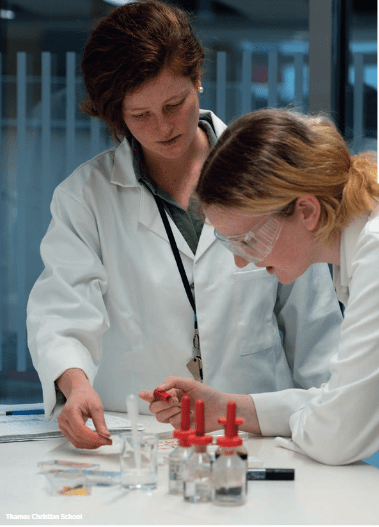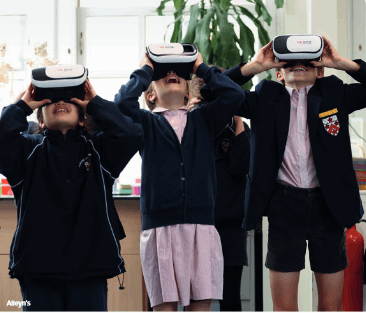The AI Revolution
AI has the power to supercharge learning, but it’s not without its challenges, says Dina Shoukry.
It’s an extremely exciting time to be alive, to be in the world and to be in education,” exclaims Jane Lunnon, Head at Alleyn’s School. “AI is vexing and challenging but it also provides a vast opportunity to teach our children not to be frightened in the face of new and exciting innovations.”
In fact, analytical and creative thinking, AI and big data will be the top-in-demand skills by 2027 according to the World Economic Forum’s Future of Jobs 2023 report.
“We must provide an education that’s right for this century, not the last one, which sadly, lots of education is based on,” says Suzie Longstaff, Principal of London Park Schools So, while there is talk in the education
sector about banning AI-driven language tools or bots such as GPT, many believe that the real question is not whether students should be using AI – most will already be using it in their day-to-day lives – but rather how to teach them to use it responsibly.
“Pretty much every school will say that they don’t teach their kids to give answers, but rather to ask the right questions,” says Lunnon. “Well, ChatGPT is that on steroids. It works most effectively and powerfully if you ask it the right questions and are judicious in your use of it.”

Stephen Holsgrove, Head of Thames Christian School agrees, “There is a lot of fear about AI because people don’t understand what it is or what it can do. Those who are able to think, be creative and problem solve will be able to navigate the world of AI. At the end of the day, it’s a tool that’ll do what it’s told. Using it well will set people apart.”
James Mutton, Deputy Head (Curriculum and Digital Innovation) at Putney High School GDST says, “You have to know what you are putting in and what you are getting out and then be able to adapt and change it. At Putney High, we’ve introduced Python coding language in Year 9 as one of the modern languages. It’s a way to upskill students in logical thinking which is what they need to be able to leverage AI.”
WHY PYTHON IS A MODERN LANGUAGE
Every year students leave Putney High School to pursue language degrees at the UK’s top universities. Language learning brings enormous cognitive benefits and opens doors to new cultures and creativity.
Global opportunities, along with advances in AI mean that understanding foreign languages, including digital ones, is increasingly important. In recognition of this, coding language Python has now been added to Putney’s long list of Modern Language options.
Python can now be studied as a third language in Year 9 alongside the five modern foreign languages: French, German, Italian, Spanish and Mandarin, and classics such as Latin. Of course, it is still taught in Computer Science and Design Thinking, and coding remains a popular student club; but this innovation in the curriculum gives those favouring STEM subjects even greater opportunity to explore Python in depth.
Source: Putney High School GDST
What about cheating? If students can simply instruct ChatGPT to do their homework – and it can simulate their writing style – then won’t everyone be doing it? Of course, cheating will become more difficult to detect, but most teachers know what their students are capable of, so such a scenario presents itself with a teachable moment in responsible use. Mostly schools are finding that students just want to learn from it. “Once you inculcate in them a sense of integrity and ownership, then they will do the right thing,” says Dr Adrian Rainbow, Head at Eaton Square Senior School.
However, it does raise the bigger question – have online tools like ChatGPT rung the death knell for homework? The answer is no, but educators have to change the way they do that too. “ChatGPT is simply accelerating what has been happening in schools for a long time,” explains Lunnon. “At Alleyn’s, we’ve always believed that flipped learning is a fantastic way to use student and teacher time and anchor good learning.” Flipped learning is essentially a reversal of how homework has traditionally been done where teachers teach a topic and then children go home and practise it. Flipped learning is where the children do the reading and research before the class – and they can use AI and ChatGPT as part of that. “So, when the children come into the classroom, there is an established sense of shared knowledge and information which we will then assess through discussion or some kind of written or online task in the classroom,” adds Lunnon.

What about how schoolwork and coursework is assessed? “It is going to put rocket boosters behind the whole conversation about assessment reform,” says Dr John Taylor, Director of Learning, Teaching & Innovation at Cranleigh School. “We have to move from a conception of learning as the recall of right answers to envisaging it as a creative process of response to open-ended questions. Projects, practical challenges, questions that learners choose for themselves – these are going to become the staple diet of ongoing assessment in the AI-assisted educational domain.”
In fact, in March this year, the regulatory body, Joint Council for Qualifications, produced detailed guidelines that apply to all schools nationally, to ensure that AI is acknowledged and recorded in students’ work. “This is an important step because what they are saying is that AI can be used in assessment contexts, but it has to be carefully tracked and monitored,” says Taylor.
Of course, AI is nothing new. Teachers have been using online educational programmes for years, but it’s the speed of its development that has taken us by storm. Used correctly, it can take a lot of the heavy lifting off time-poor teachers. AI can provide simple explanations for complex topics, it can even mark work and provide detailed and extensive feedback, freeing up teachers’ time for higher order thinking, individualised support, debate and teamwork with students. “It will free up time for staff to be able to have these wonderful moments of inspiration in the classroom where they are lighting the spark for their children to think differently,” says Rainbow.
What about original thought? Will AI simply do the thinking for our children? “I worry that dissenting thought will be suppressed,” warns Adam D’Souza, founder of tutoring company, Commons Education. “If using AI becomes de-facto essential in order to keep up with the relentless pace of the pack, then where will be the space and time to develop original ideas or viewpoints?”
On the contrary, many believe it will empower children to be even bolder with their ideas. “I don’t think AI will stifle creativity because students are able to do more advanced things with it. If they’re writing a creative story, they can evoke an image and then use coding language to modify it in any way they want,” says Mutton.
“It can personalise their education, and introduce new and engaging learning experiences, such as virtual reality and interactive simulations,” adds Sally Maskell, Head of Science & Digital Learning at Streatham & Clapham Prep School.

Social inequality is also a big barrier to AI. “My fear is that those with existing literacy will be able to write effective, precise prompts and massively increase their output, while those who have struggled with literacy or who lack financial resources to buy AI-enabled devices will be left even further behind, with widening social and economic inequality between the AI haves and have nots,” says D’Souza.
There is of course a real economic divide with regards to access to devices as well as the cost of AI tools which are often subscription-based, but when it comes to abilities, advocates believe that AI can be a great leveller. “If you are a learner who has difficulty expressing yourself, or communicating in a second language, this tool will help you to organise your thinking, suggest new lines of inquiry, and point you towards new directions for your research,” explains Taylor. AI can also be a game-changer for neurodivergent children or those with a learning need who find it difficult to communicate.

Like any tool, AI has its limitations. ChatGPT scours the internet for information, but as we all know, not everything online is correct, accurate or unbiased. “AI is only as creative and intelligent as it is trained to be,” says Holsgrove. “Use it for what it’s good for, to stimulate your thinking and spur you on in different directions, but never ever let it become your master.”
This raises the issue of safeguarding too. “You must check the facts, the source and be confident that it is not dangerous or harmful to children. We do this all the time at Cranleigh through teaching digital literacy and the importance of distinguishing between information and misinformation,” says Taylor. “But AI is much more personalised and so we need to be aware of the danger of students getting into personal conversations and sharing personal data because when they are typing and chatting and receiving responses, they’re going to assume they are chatting to someone.”
In all the hype about AI, both positive and negative, “It’s important that we don’t lose sight of what makes us human, and our own critical thinking skills and faculties More than ever, there’s a need for emphasis on soft skills as well as the technological skills,” says Paul Vanni, Head of London Park School Clapham. Indeed, the World Economic Forum also highlights curiosity for life-long learning, resilience and agility among the top ten job skills needed in the future. A machine simply can’t teach those, but a human can.






